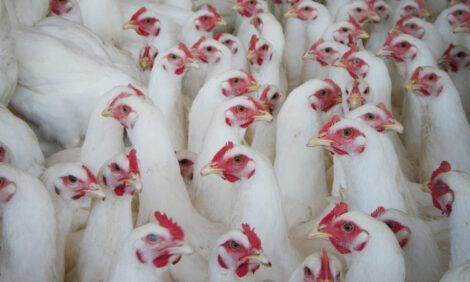



Improving Energy Efficiency for Broiler Farms
By Edgar O. Oviedo, DVM. Phd. Dipl. ACPV. Assistant Professor/ Extension Specialist, Department of Poultry Science, North Carolina State University. Published in the North Carolina Poultry Industry Joint Area Newsletter - Fall 2007.Winter is coming and it is time to prepare the houses for higher gas consumption. Propane gas prices and electricity costs will continue to increase. It is more important than ever before to make the houses and the farm more energy efficient. The work and investments done now will definitely pay back in the next months. To evaluate the benefits of your investments and changes in management, you need to record propane gas and electricity consumption every month or use bills as a reference. Comparing monthly data will reflect the success of your energy conservation program. These are some energy saving ideas for broiler farms:
Plan strategic brooding management. Most of the gas in broiler houses is used for brooding. Make a plan to optimize propane use, and maintain or even improve broiler performance. Do a good preheating of the house to have a uniform average litter temperature around 92 oF in the whole brooding area at placement of chicks. Maintain this temperature only for two or maximum three days, and start gradually reducing brooder temperature settings daily. Do not forget to maintain minimum ventilation. Radiant heaters are more efficient to warm the litter surface than pancake heaters. Side wall heaters will help you better to warm the air, but not the litter. If your chickens have a good start during the first three days, they will eat and start growing fast, producing enough metabolic heat that you will have to give them lower house temperatures to keep them comfortable, and consequently burning less gas. If chickens don’t have a good reception, they normally require more heat during the rest of the brooding phase. In this case, reducing temperature and/or ventilation is detrimental for flock performance. In conclusion, good house and litter preheating will save you gas in the long term. Make daily and small gradual reductions (1º to 3ºF) in brooder and heater settings to guarantee optimum comfort for the flock and save gas.
Implement a good brooder maintenance program. Keep the burner orifices clean. Sooty brooders indicate improperly burning of fuel and production of more carbon monoxide which is toxic for birds and humans. Use the proper size reaming needle to avoid altering the orifice size and wasting fuel. Adjust the pilot lights in the heaters to manufacturer’s specifications. Shut off one-half the brooder pilot lights when they are not needed. In cold weather, the lit brooders provide heat until unlit brooders can be reignited.
Check gas regulator on the gas tank, gas line pressure and gas leaks. Inadequate pressure of gas can cause inefficiencies in the heaters. For safety do not, under any circumstance, make adjustments to the regulator on the gas tanks—contact the gas company provider, and never test gas leaks with an open flame.
Maintain house controllers, sensors and thermostats. Most broiler houses are controlled by electronic devices. Timers, sensors and thermostats loose accuracy with time, dust and humidity. Clean, test and recalibrate this equipment to make sure the house maintains the conditions that you will program in the controller during the whole day.
Keep heat in the house and avoid uncontrolled air entries. Most of the energy efficiency is lost during winter time when uncontrolled cold air enters the house due to wall cracks or curtain holes. Caulk sill plates and seal cracks with expanding polyurethane foam, repair all curtain holes and eliminate cracks between curtain and house. To fit curtains close to the wall and cover the entire sidewall opening, you can install pocket flaps over the tops and ends of curtains. Make sure to insulate the tunnel inlets with curtains or insulated doors. Cover and seal all unused fan openings with plastic sheeting or curtain material. Clean shutters that allow unwanted air entry. Engineers say that a 1/8-inch crack along both sides of a 500-ft. house is equivalent to more than 10 sq. ft. of open wall or leaving uncovered a 2-ft. section of sidewall.
Adequate insulation for your weather conditions. Broiler houses with solid side walls are more energy efficient than houses open sided with curtains. However, you can insulate open sided houses at least on the brooding chamber. Several new materials are available in the market. Independently of the type of house you have, repair or replace insulation in the ceiling and walls damaged or destroyed by rodents and insects. The insulation efficiency or minimum thermal resistance (R-value) of most insulation materials decreases drastically when moistened. Install vapor barriers inside of the brooding chamber to avoid build-up of humidity.
Avoid water leaks to save energy. Excess litter moisture in the house requires heat for moisture evaporation and removal. Reduce litter moisture by properly ventilating when adequate according to age of flock and weather. Do not delay the increments in ventilation rates, otherwise litter moisture will raise and it will be more energy expensive to get rid of extra humidity in the houses. Increasing ventilation rate should only be done during the warmest periods of the day.
Avoid temperature stratification by using mixing fans. Warmer air tends to go to the ceiling and cooler air near the floor where it is not needed. Mixing fans help to circulate air and maintain a more uniform temperature at all levels to guarantee chick comfort. This will reduce the amount of gas needed to guarantee optimum temperatures.
Replace incandescent bulbs with energy efficient alternatives. Light emitting diode (LED) lights and cold cathode lights use less energy than incandescent lights, last longer and are dimmable. One 5 watt cold cathode bulb will produce the same light as a 40 watt incandescent bulb. New dimmable fluorescent lights hooked to a timer and photocell combination allow for the proper amount of light to be maintained in the houses while reducing energy usage. The photo cells measure light levels in several locations in the house and the individual lights are controlled to provide just the required amount of light and no more. Light reflectors on fixtures can double the amount of light that reaches the birds and reduce lighting costs by one-half.
Updating houses. Several equipment companies are promoting different types of ceiling vents to utilize solar heat trapped in the attic of the houses. These attic vents could help to reduce the gas consumption by more than 15%, have more recirculation of air, maintain better litter quality, and reduce CO2 concentration in the brooding chambers. When replacing poultry house fans, select the most efficient fans suited for your needs. If you need to change brooders evaluate using tube radiant brooders.
Producing energy. It is time to start thinking about solar panels to generate electricity. These systems are already under evaluation in commercial broiler houses not only to generate and save energy in batteries for the farm, but also to sell power back to the grid.
If you are interested in learning more about these saving ideas or want to do a test, please contact us at the Department of Poultry Science at NC State University.











